Handsome and talented actor Jorge Mistral (1920-1972) became a star in Spanish films during the 1940s. In the 1950s, he lived and worked in México and appeared in Luis Buñuel's Abismos de pasión / Wuthering Heights (1954). Later, in the 1960s, he directed three films.

Spanish postcard by Cinema - Revista Quincenal.
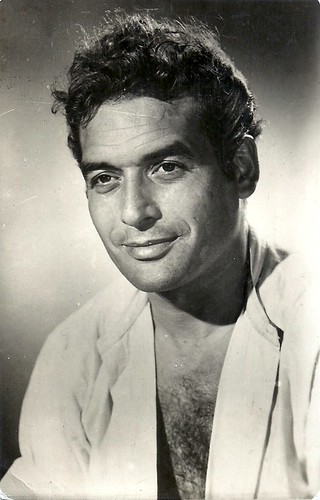
Spanish postcard, no. 2714.
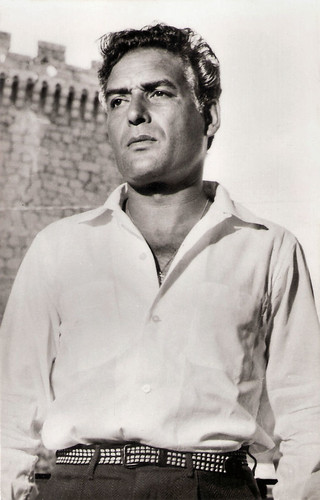
Spanish postcard by Soberanas, Barna, no. 263.
Jorge Mistral was born Modesto Llosas Rosell in 1920 in Aldaya, Spain. His father was from Puerto Rico, and his mother from Catalonia. Since childhood, Jorge was interested in artistic activities. In 1943, he abandoned his law studies and began to work in the theatre company of Enrique Borrás, at the time one of the most prestigious Spanish-speaking actors.
A year later, he made his film debut in La llamada del mar / Call of the Sea (José Gaspar, 1944). The film nor his performance impressed anyone. In the next years, he studied alongside renowned actors, and his talent and good looks led him to success. Mistral became a star in films produced by Spain's largest studio, Cifesa. His breakthrough was Misión blanca / White Mission (Juan de Orduña, 1946), in which he co-starred with Manuel Luna and Fernando Rey. The film, about a religious mission in the Spanish Empire, was shot on location in Spanish Guinea and in a Spanish studio.
In 1948, he appeared in the historical drama in Locura de amor / Madness for Love (Juan de Orduña, 1948) with Aurora Batista, Fernando Rey and Sara Montiel. The film tells the story of Queen Joanna of Castile (Batista), known as ‘Juana la loca’, and her husband Philip I of Castile (Rey), also known as ‘Philip the handsome’.
At IMDb, Ignacio Martinez-Ybor reviews: “This movie was part of a propaganda effort of the Franco regime to extol the ‘traditional’ values of the ‘true’ Spain ..... by true is meant nationalistic, non-foreign characters in the plot, the archvillains being the Flemish allies of the King and the Moorish girl played by a very young Sarita Montiel. (…) As merely a movie, Locura de Amor is quite engaging, in a compressed telenovela sort of way (…) Jorge Mistral played handsomely and sympathetically a part which required him to look handsome and be sympathetic.”
The following year, he made the drama Currito de la Cruz / Currito of the Cross (Luis Lucia, 1949) starring Pepín Martín Vázquez, and the expensive costume drama La duquesa de Benamejí / The Duchess of Benameji (Luis Lucia, 1949) starring Amparo Rivelles in dual roles as a countess and a gypsy. In the comedy La hermana San Sulpicio / Sister San Sulpicio (Luis Lucia, 1952) and the musical Un caballero andaluz / An Andalusian Gentleman (Luis Lucia, 1954), he co-starred with Carmen Sevilla.
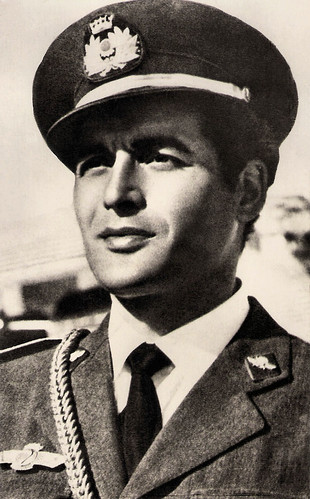
Spanish postcard by J.R., B. Photo: publicity still for La trinca del aire / Lashing the air (Ramón Torrado, 1951).

Spanish postcard by Marte. Photo: publicity still for La trinca del aire / Lashing the air (Ramón Torrado, 1951).

Cover page of a film programme by Illustrierte Film- Bühne, no. 3707. Jorge Mistral and Marisa Allasio in Le schiave di Cartagine / The Sword and the Cross (Guido Brignone, 1956).
From the 1950s on, Jorge Mistral also worked in Cuba and Argentina. Later, he often worked in México, which became his second homeland. There, Mistral achieved enormous popularity opposite Gloria Marin in the classic tearjerker El derecho de nacer / The Right to Be Born (Zacarías Gómez Urquiza, 1952), an unprecedented blockbuster in Mexico.
One of his best-known Mexican films is Luis Buñuel's Abismos de pasión / Wuthering Heights (1953), based on the Emily Brontë novel 'Wuthering Heights'. The film starred Irasema Dilián and Mistral as the Cathy and Heathcliff characters. Gabriela Zayas at IMDb: “Buñuel's genius operates the miracle, aided by his excellent cast and team. This is the one version that captures the roots of Cathy's and Heathcliff's deep and contradictory emotions, the passions, the love and hate they shared and suffered, being all of them doomed to be unhappy in this world and hoping to be redeemed and united in the other. Placed in Mexico, black and white excellent photography, with a believable and intense cast, and a passionate, yet sometimes ironic direction.”
Mistral continued to star in European films like the Italian-Spanish Film Noir Il mondo sarà nostro / Andalusia Express (Francisco Rovira Beleta, 1956), also with Vincente Parra and Mara Berni, and the Italian religious drama La spada e la croce / The Sword and the Cross (Carlo Ludovico Bragaglia, 1958) with Hollywood star Yvonne De Carlo as Mary Magdalene.
Mistral had a supporting part as the lazy fisherman lover of Sophia Loren in the Hollywood production Boy on a Dolphin (Jean Negulesco, 1957), set in Greece. The romantic film is noteworthy as Loren's English language debut, and also starred Alan Ladd and Clifton Webb. Mistral also appeared opposite Zully Moreno in the Argentine romantic drama Amor prohibido / Prohibited Love (Luis César Amadori, 1958), based on 'Anna Karenina' by Leo Tolstoy.
In Spain, he starred in La venganza / Vengeance (Juan Antonio Bardem, 1958) with Carmen Sevilla and Raf Vallone. La venganza was shown at the 1958 Cannes Film Festival and was nominated for the Academy Award for Best Foreign Language Film. But the film was not released in Spain under General Franco until the following year and had serious troubles with fascist censorship. Director Bardem even went to prison, which caused an international scandal.

German press photo by ORF Fotodienst, 1988. Sophia Loren in Boy on a Dolphin (Jean Negulesco, 1957) with on the back Jorge Mistral.
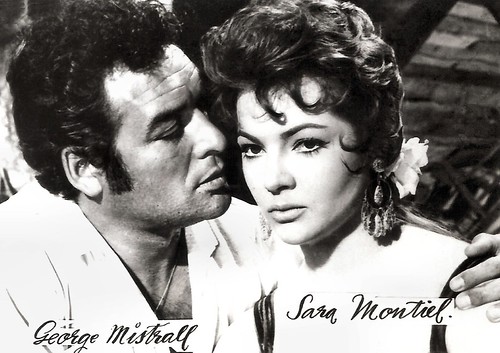
Romanian collector card. Publicity still for Carmen de la Ronda / A Girl Against Napoleon (Tulio Demicheli, 1959) with Sara Montiel.
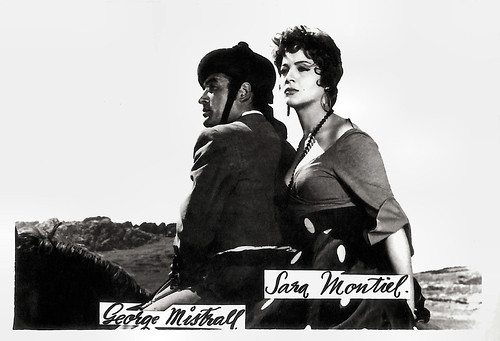
Romanian collector card. Publicity still for Carmen de la Ronda / A Girl Against Napoleon (Tulio Demicheli, 1959) with Sara Montiel.
Jorge Mistral co-starred with Sara Montiel and Maurice Ronet in the Spanish historical adventure film Carmen la de Ronda / A Girl Against Napoleon (Tulio Demicheli, 1959). The film was loosely based on the story of Prosper Mérimée's 'Carmen', with the setting changed to the Peninsular War era. Carmen is involved with the Guerrilla fighting against the French occupation.
During the 1960s, Mistral’s film parts became smaller. He played a supporting part in the Mexican drama Juana Gallo (Miguel Zacarías, 1961), which was entered into the 2nd Moscow International Film Festival. In Argentina, he appeared in the drama Bajo un mismo rostro / Under the Same Skin (Daniel Tinayre, 1962). In France, he played the Grand Vizir Zaccar in Shéhérazade (Pierre Gaspard-Huit, 1963), starring Anna Karina. He also appeared in the Eurowestern Los Pistoleros de Casa Grande / Gunfighters of Casa Grande (Roy Rowland, 1964), co-produced by American and Spanish producers and starring Alex Nicol.
Jorge Mistral also directed three films: La Piel desnuda / The Bare Skin (1966) with Marta Romero, La Fiebre del deseo / The Fever of Desire (1966) with Kitty de Hoyos, and Crimen sin olvido / Crime Without Oblivion (1968) starring Rosángela Balbó. The latter was never released.
Although he kept playing in films and TV series, his efforts were less prominent than in the 1940s and 1950s. His final film appearance was a small part in the Mexican crime-comedy Diamantes, oro, y amor / Diamonds, Gold and Love (Juan Manuel Torres, 1973). Mistral married three times. In Argentina, he married Olga Marchetti, with whom he had a daughter who died a few days after her birth. He also married Cristina Ruiz Cano and Graciela Dufau, but all his marriages ended in divorce.
In 1972, Jorge Mistral committed suicide with a gunshot. He was only 51 when he died in Mexico City. In his blog El Lado Oscuro de Hollywood, Jesús Iglesias Lerroux notes that just a few days before his death, Mistral had served as a reciter in several nightclubs in Mexico City. The critics and audiences applauded him in his new role, but Mistral had only done it for the money. Debt-ridden, prematurely old-looking, ill and alone, Mistral had not considered his life worth living any longer. His death was deeply felt in the Spanish-speaking countries.
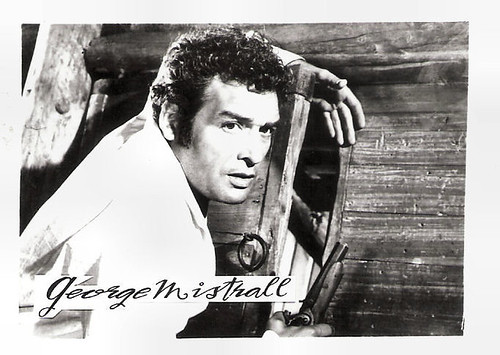
Romanian collector card.
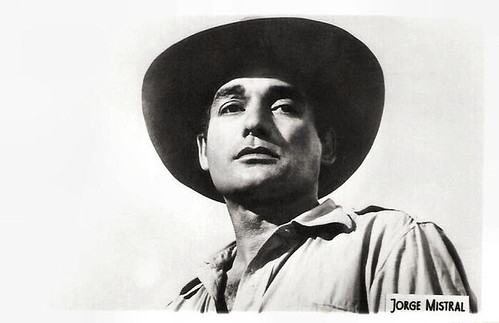
Romanian collector card.
Sources: Jesús Iglesias Lerroux (El Lado Oscuro de Hollywood - Spanish), Wikipedia and IMDb.
This post was last updated on 26 September 2025.

Spanish postcard by Cinema - Revista Quincenal.

Spanish postcard, no. 2714.

Spanish postcard by Soberanas, Barna, no. 263.
Look handsome and be sympathetic
Jorge Mistral was born Modesto Llosas Rosell in 1920 in Aldaya, Spain. His father was from Puerto Rico, and his mother from Catalonia. Since childhood, Jorge was interested in artistic activities. In 1943, he abandoned his law studies and began to work in the theatre company of Enrique Borrás, at the time one of the most prestigious Spanish-speaking actors.
A year later, he made his film debut in La llamada del mar / Call of the Sea (José Gaspar, 1944). The film nor his performance impressed anyone. In the next years, he studied alongside renowned actors, and his talent and good looks led him to success. Mistral became a star in films produced by Spain's largest studio, Cifesa. His breakthrough was Misión blanca / White Mission (Juan de Orduña, 1946), in which he co-starred with Manuel Luna and Fernando Rey. The film, about a religious mission in the Spanish Empire, was shot on location in Spanish Guinea and in a Spanish studio.
In 1948, he appeared in the historical drama in Locura de amor / Madness for Love (Juan de Orduña, 1948) with Aurora Batista, Fernando Rey and Sara Montiel. The film tells the story of Queen Joanna of Castile (Batista), known as ‘Juana la loca’, and her husband Philip I of Castile (Rey), also known as ‘Philip the handsome’.
At IMDb, Ignacio Martinez-Ybor reviews: “This movie was part of a propaganda effort of the Franco regime to extol the ‘traditional’ values of the ‘true’ Spain ..... by true is meant nationalistic, non-foreign characters in the plot, the archvillains being the Flemish allies of the King and the Moorish girl played by a very young Sarita Montiel. (…) As merely a movie, Locura de Amor is quite engaging, in a compressed telenovela sort of way (…) Jorge Mistral played handsomely and sympathetically a part which required him to look handsome and be sympathetic.”
The following year, he made the drama Currito de la Cruz / Currito of the Cross (Luis Lucia, 1949) starring Pepín Martín Vázquez, and the expensive costume drama La duquesa de Benamejí / The Duchess of Benameji (Luis Lucia, 1949) starring Amparo Rivelles in dual roles as a countess and a gypsy. In the comedy La hermana San Sulpicio / Sister San Sulpicio (Luis Lucia, 1952) and the musical Un caballero andaluz / An Andalusian Gentleman (Luis Lucia, 1954), he co-starred with Carmen Sevilla.

Spanish postcard by J.R., B. Photo: publicity still for La trinca del aire / Lashing the air (Ramón Torrado, 1951).

Spanish postcard by Marte. Photo: publicity still for La trinca del aire / Lashing the air (Ramón Torrado, 1951).

Cover page of a film programme by Illustrierte Film- Bühne, no. 3707. Jorge Mistral and Marisa Allasio in Le schiave di Cartagine / The Sword and the Cross (Guido Brignone, 1956).
International scandal
From the 1950s on, Jorge Mistral also worked in Cuba and Argentina. Later, he often worked in México, which became his second homeland. There, Mistral achieved enormous popularity opposite Gloria Marin in the classic tearjerker El derecho de nacer / The Right to Be Born (Zacarías Gómez Urquiza, 1952), an unprecedented blockbuster in Mexico.
One of his best-known Mexican films is Luis Buñuel's Abismos de pasión / Wuthering Heights (1953), based on the Emily Brontë novel 'Wuthering Heights'. The film starred Irasema Dilián and Mistral as the Cathy and Heathcliff characters. Gabriela Zayas at IMDb: “Buñuel's genius operates the miracle, aided by his excellent cast and team. This is the one version that captures the roots of Cathy's and Heathcliff's deep and contradictory emotions, the passions, the love and hate they shared and suffered, being all of them doomed to be unhappy in this world and hoping to be redeemed and united in the other. Placed in Mexico, black and white excellent photography, with a believable and intense cast, and a passionate, yet sometimes ironic direction.”
Mistral continued to star in European films like the Italian-Spanish Film Noir Il mondo sarà nostro / Andalusia Express (Francisco Rovira Beleta, 1956), also with Vincente Parra and Mara Berni, and the Italian religious drama La spada e la croce / The Sword and the Cross (Carlo Ludovico Bragaglia, 1958) with Hollywood star Yvonne De Carlo as Mary Magdalene.
Mistral had a supporting part as the lazy fisherman lover of Sophia Loren in the Hollywood production Boy on a Dolphin (Jean Negulesco, 1957), set in Greece. The romantic film is noteworthy as Loren's English language debut, and also starred Alan Ladd and Clifton Webb. Mistral also appeared opposite Zully Moreno in the Argentine romantic drama Amor prohibido / Prohibited Love (Luis César Amadori, 1958), based on 'Anna Karenina' by Leo Tolstoy.
In Spain, he starred in La venganza / Vengeance (Juan Antonio Bardem, 1958) with Carmen Sevilla and Raf Vallone. La venganza was shown at the 1958 Cannes Film Festival and was nominated for the Academy Award for Best Foreign Language Film. But the film was not released in Spain under General Franco until the following year and had serious troubles with fascist censorship. Director Bardem even went to prison, which caused an international scandal.

German press photo by ORF Fotodienst, 1988. Sophia Loren in Boy on a Dolphin (Jean Negulesco, 1957) with on the back Jorge Mistral.

Romanian collector card. Publicity still for Carmen de la Ronda / A Girl Against Napoleon (Tulio Demicheli, 1959) with Sara Montiel.

Romanian collector card. Publicity still for Carmen de la Ronda / A Girl Against Napoleon (Tulio Demicheli, 1959) with Sara Montiel.
Suicide with a gunshot
Jorge Mistral co-starred with Sara Montiel and Maurice Ronet in the Spanish historical adventure film Carmen la de Ronda / A Girl Against Napoleon (Tulio Demicheli, 1959). The film was loosely based on the story of Prosper Mérimée's 'Carmen', with the setting changed to the Peninsular War era. Carmen is involved with the Guerrilla fighting against the French occupation.
During the 1960s, Mistral’s film parts became smaller. He played a supporting part in the Mexican drama Juana Gallo (Miguel Zacarías, 1961), which was entered into the 2nd Moscow International Film Festival. In Argentina, he appeared in the drama Bajo un mismo rostro / Under the Same Skin (Daniel Tinayre, 1962). In France, he played the Grand Vizir Zaccar in Shéhérazade (Pierre Gaspard-Huit, 1963), starring Anna Karina. He also appeared in the Eurowestern Los Pistoleros de Casa Grande / Gunfighters of Casa Grande (Roy Rowland, 1964), co-produced by American and Spanish producers and starring Alex Nicol.
Jorge Mistral also directed three films: La Piel desnuda / The Bare Skin (1966) with Marta Romero, La Fiebre del deseo / The Fever of Desire (1966) with Kitty de Hoyos, and Crimen sin olvido / Crime Without Oblivion (1968) starring Rosángela Balbó. The latter was never released.
Although he kept playing in films and TV series, his efforts were less prominent than in the 1940s and 1950s. His final film appearance was a small part in the Mexican crime-comedy Diamantes, oro, y amor / Diamonds, Gold and Love (Juan Manuel Torres, 1973). Mistral married three times. In Argentina, he married Olga Marchetti, with whom he had a daughter who died a few days after her birth. He also married Cristina Ruiz Cano and Graciela Dufau, but all his marriages ended in divorce.
In 1972, Jorge Mistral committed suicide with a gunshot. He was only 51 when he died in Mexico City. In his blog El Lado Oscuro de Hollywood, Jesús Iglesias Lerroux notes that just a few days before his death, Mistral had served as a reciter in several nightclubs in Mexico City. The critics and audiences applauded him in his new role, but Mistral had only done it for the money. Debt-ridden, prematurely old-looking, ill and alone, Mistral had not considered his life worth living any longer. His death was deeply felt in the Spanish-speaking countries.

Romanian collector card.

Romanian collector card.
Sources: Jesús Iglesias Lerroux (El Lado Oscuro de Hollywood - Spanish), Wikipedia and IMDb.
This post was last updated on 26 September 2025.
No comments:
Post a Comment